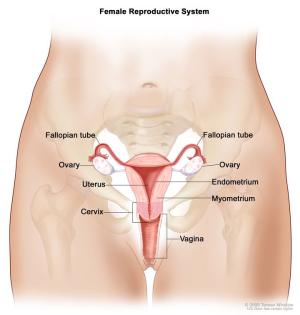Date Posted, by Goli Samimi, Ph.D., M.P.H.
Research to uncover how and why benign gynecologic conditions like endometriosis or uterine fibroids progress to invasive and deadly ovarian cancer or uterine sarcomas, is a critical and overlooked issue in women’s health. A new report on research priorities and an open funding opportunity are focused on addressing this issue.
In April 2019, Program Directors from the Division of Cancer Prevention and the Division of Cancer Biology within the National Cancer Institute (NCI) and the Gynecologic Health and Disease Branch within the National Institute of Child Health and Human Development (NICHD) organized a joint workshop with experts in benign and malignant gynecologic diseases to identify interesting and important research questions related to the biology, epidemiology and clinical characteristics involved in the processes by which gynecologic cancers progress from benign gynecologic conditions.
This workshop focused on three gynecologic diseases and their potentially related cancers: endometriosis and endometriosis-associated ovarian cancer; uterine fibroids and leiomyosarcoma; and adenomyosis and endometrial adenocarcinoma.
The recently published report highlights the research questions and challenges related to these diseases that were discussed during this workshop. Across disease types, common questions included:
- What is the biological mechanism involved with the benign condition progressing to cancer?
- How can we improve diagnosis of these diseases?
- What non-surgical options are effective for treatment?
- What experimental models are available to further study these diseases?
- How can we better identify women who are at increased risk for these diseases?
Endometriosis occurs when endometrial tissue (which usually lines the inside of the uterus) grows outside the uterus, affecting from 3% to 10% of premenopausal women. Symptoms of endometriosis include irregular menstruation and pelvic pain. Endometriosis is generally treated with hormones and/or surgery.
Endometriosis can sometimes be associated with certain cancer types called clear cell or endometrioid ovarian cancer. These cancer types are often identified at an early stage at diagnosis and the disease is not aggressive. These cancers are different than endometrial cancer, the most common gynecologic cancer in the United States. Endometrial cancer happens in the uterus but is not thought to be associated with endometriosis. These cancer types are primarily treated with surgery, but alternative treatment options (such as hormonal treatments) for non-surgical candidates are desirable and needed.
Research questions in endometriosis and related cancers include molecular and hormonal characterization of benign and tumor tissues; developing mouse models; evaluating pain related to these conditions; and finding risk factors to predict risk of developing cancer.
Uterine fibroids (also known as leiomyomas) are benign growths from the smooth muscle cells that makes up the middle tissue that lines the uterus (called the myometrium). Fibroids are the most common benign gynecologic disease; symptoms include irregular menstruation and pelvic pain. They are generally treated with hormones and/or surgery. Uterine fibroids can sometimes be associated with uterine leiomyosarcomas (LMS), a very rare cancer that arises from the myometrium. These cancers tend to have poorer outcomes and are treated with surgery.
Research questions in fibroids and leiomyosarcoma research include creating registries and cohorts to learn natural history and create biospecimen sets; studying the natural history of hormonal transitions such as perimenopause, pregnancy and menopause and how this affects fibroids; and innovating nonsurgical therapies.
Adenomyosis occurs when endometrial tissue breaks through the smooth muscle middle layer of the uterus and may affect up to 20% of women of reproductive age. Adenomyosis is a fairly common diagnosis; however, the real prevalence is not exactly known because the symptoms (menstrual cramps, lower abdominal pressure, and bloating) are relatively common. Adenomyosis treatment ranges from pain relievers to hormonal therapy to ablation, depending on severity of the symptoms. The presence of adenomyosis is associated with endometrial adenocarcinoma, the most common gynecologic cancer.
Research questions on adenomyosis and adenocarcinoma include: creating a comprehensive evaluation of hysterectomy specimens of patients with the condition; formalizing ultrasound imaging criteria for adenomyosis; and developing an adenomyosis classification based on multiple factors, including genetics.
A new funding opportunity from NICHD supports research into the development of Centers to Advance Research in Endometriosis (CARE). This program will incorporate collaborative biologic and/or clinical studies to accelerate research into the causes and mechanisms of progression of endometriosis, and the development of more effective strategies for endometriosis diagnosis, treatment/management, and prevention.
The NCI has signed on as a participating organization to potentially co-fund a cancer-related project within a proposed grant. This funding opportunity is an exciting next step because it provides an opportunity for both NCI and NICHD to fund research together that studies, in part, how endometriosis may progress to endometriosis-associated cancer. The hope is that this collaborative research will help identify ways to prevent certain types of endometrial cancer in women who have these benign or pre-cancerous conditions.
Reference
Samimi G, Sathyamoorthy N, Tingen CM, Mazloomdoost D, Conroy J, Heckman-Stoddard B, et al. Report of NCI and NICHD-Sponsored Workshop: Gynecology and Women's Health-Benign Conditions and Cancer. Am J Obstet Gynecol. 2020.
If you would like to reproduce some or all of this content, see Reuse of NCI Information for guidance about copyright and permissions. Please credit the National Cancer Institute as the source and link directly to the blog post using the original title, for example: "Research Issues in Gynecology and Women's Health: How do Benign Conditions Become Cancer? was originally published by the National Cancer Institute." For questions, contact us at CancerPreventionBlog@mail.nih.gov.

